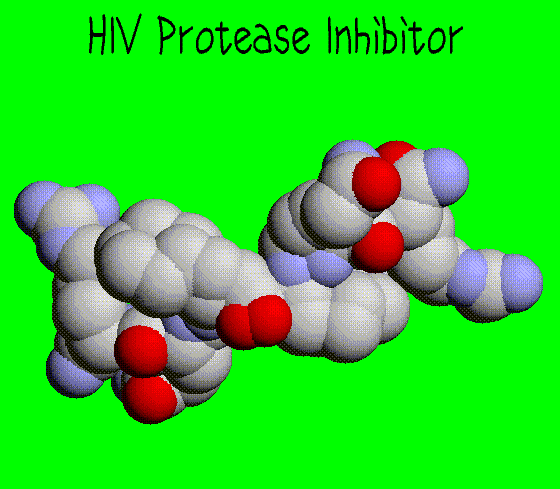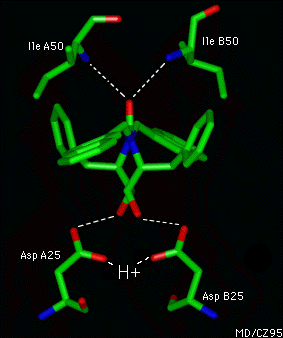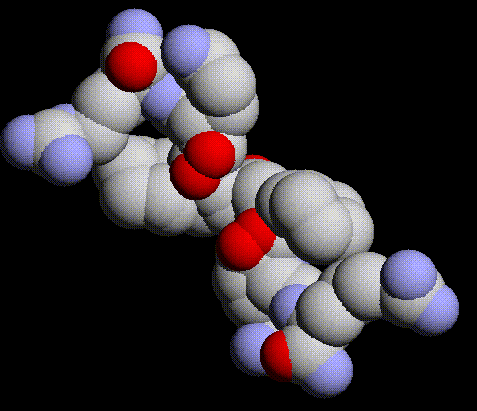
Protease inhibitors are a new class of drugs that works by blocking
the HIV protease. Once the protease is blocked, HIV makes copies of itself
that cannot infect other cells. These protease inhibitors seem to be less
toxic and seem to have less severe side affects than other anti-AIDS drugs
(nucleoside analogs like AZT) Saquinavir
, ritonavir, and indinavir are the
three main HIV protease inhibitors available today. For a comparison chart
of the three protease inhibitors click here.
History
Scientists had been tryng to design and synthesize
inhibitors of human resin (protease in the kidneys). Human renin plays
a key role in regulating blood pressure. It was believed that a renin inhibitor
could be a highly effective drug for controlling hypertension. The HIV
protease is similar in structure and function. Therefore, there was already
an abundance of knowledge and experience in building inhibitors to proteases
of this type. All the protease inhibitors were modeled after the compounds
first developed for renin.
How do protease inhibitors work?
Protease inhibitors resemble the protein chain
that the protease cuts. The protease inhibitor binds to the site that normally
binds the protein chain. Once the inhibitor binds the protease cannot bind
the protein to be cleaved and is not functional. In order to make optimum
use of the genes, HIV makes long nonfunctional polypeptide chains that
are precursers to the actual proteins and enzymes. Although new viruses
are made, if the polypeptide chain is uncleaved, the virus cannot make
the necessary enzymes to infect other cells. Protease inhibitors do not
cure AIDS, they can only decrease the number of infectious copies of HIV.
 This
picture shows the HIV protease (purple and green) complexed with the inhibitor
(spacefill). This prevents the substrate from reacting with the protease
and thus, the polypeptides are not cleaved. For veiwing of the complex in
rasmol click on the picture. oooooooooo oooooo
ooo oo ooo ooo ooooooooo ooo ooo oooooo ooo oo oooooo oo oooooooo oooooo
ooooo oo oooooooooo oooooooo ooooooo ooooooo ooooo ooooo oo ooooo oooo.
ooooo ooooo ooooo oo oo ooooooo.
This
picture shows the HIV protease (purple and green) complexed with the inhibitor
(spacefill). This prevents the substrate from reacting with the protease
and thus, the polypeptides are not cleaved. For veiwing of the complex in
rasmol click on the picture. oooooooooo oooooo
ooo oo ooo ooo ooooooooo ooo ooo oooooo ooo oo oooooo oo oooooooo oooooo
ooooo oo oooooooooo oooooooo ooooooo ooooooo ooooo ooooo oo ooooo oooo.
ooooo ooooo ooooo oo oo ooooooo.
 This
shows the interaction between HIV protease inhibitor and the residues that
hydrogen bond to the inhibitor. Aspartate A25 and B25 and isoleucine A50
and B50 are hydrogen bonded to the inhibitor. ooooo
ooooo oooo oooooooooooo ooooooooooooooooooo ooo o o oooooooo oo
ooooo oooooooo oooo oooo oooo ooo ooo oooo ooo.
This
shows the interaction between HIV protease inhibitor and the residues that
hydrogen bond to the inhibitor. Aspartate A25 and B25 and isoleucine A50
and B50 are hydrogen bonded to the inhibitor. ooooo
ooooo oooo oooooooooooo ooooooooooooooooooo ooo o o oooooooo oo
ooooo oooooooo oooo oooo oooo ooo ooo oooo ooo.
Saquinavir
Saquinavir which has
the trade name Invirase was the
first protease inhibitor to be approved by the FDA (December 1995) for the treatment
of HIV infection. One problem with the drug was that it had limited oral
bioavailability (did not absorb into the body well). Saquinavir must be taken
with meals that have a high fat content. However, the high fat diet does not
overcome the inhibitor going
through extensive metabolism in the liver by the hepatatic
cytochrome P450 3A system. There have been studies done to
increase the absorption of squinavir into the body. Some studies have found that
taking the drug with grapefruit juice increases the absorption. There were also many
clinical trials done using cominations of saquinavir/AZT, saquinavir/AZT/ddC,
and AZT/ddC. After 48 weeks of treatment, people taking the saquinavir/AZT
comination had an average increase of 74 T-cell. People taking AZT and ddC
had an increase of 72 T-cells and with saquinavir/AZT/ddC there was an
increase of 111 T-cells. Clearly showing that combination drug therapy is
more promising than single drug therapy.
Ritonavir has
strong interactions with many other drugs. The main problem is that
ritonavir blocks a liver
enzyme which normally destroys certain drugs, causing normal
doses of the other drug to
accumulate to toxic levels. Thus, ritonavir cannot be taken with
many drugs. However, tests have shown that Ritonavir used in combination
with other inhibitors as well as with nucleoside analogs, increases the T-cell
counts.
Indinavir's trade name is Crixivan. Indinavir,
like saquinavir and ritonavir inhibit the HIV protease. There has also
been clinical trials using single and combination drug therapy. There was a
and increase in CD4 cells for comination drug therapies. However, HIV can
be resistant to the effects of all three of the protease inhibitors. Thus,
taking a combination of both nucleoside analogs and protease inhibiters,
will lessen the chance for resistance.
Andvantages of Combination Drug Therapy
The combination of protease inhibitors and reverse
transcriptase inhibitors is possible because there is no bad
interaction between the two drugs. Protease inhibitors
are processed by the liver while reverse transcriptase inhibiters
are processed in nonliver cells. Since these two types of
drugs attack at different stages of the HIV's life cycle
there is more of a chance to cause some damage in the virus.
There is also less of a chance for the virus to become
resistant to both types of drugs.
Protease inhibitors can be combined as well. The combination
of ritonavir and saquinavir have been tested. The chance for
cross-resistance is low and ritonavir slows down the rate at
which saquinavir leaves the body and so saquinavir can stick
around longer to attack the virus.
Side Effects
The side effects for ritonavir seem to be the most
severe. Nausea, vomiting, and diarrhea are some of them. For indinavir,
the side effects are kidney stones, which can cause pain in the back
and side. Saquinavir seems to have the least side effects. Nausea, diarrhea,
and stomach discomfort occur in very few people.
 Back to Beginning
Back to Beginning
 Table
of Contents
Table
of Contents
 HIV
Protease
HIV
Protease
 HIV
Protease Inhibitors
HIV
Protease Inhibitors
 Saquinavir
Saquinavir
 Conclusion
Conclusion
 Grace's
Homepage
Grace's
Homepage
This page was last updated on January 29, 1997


 This
picture shows the HIV protease (purple and green) complexed with the inhibitor
(spacefill). This prevents the substrate from reacting with the protease
and thus, the polypeptides are not cleaved. For veiwing of the complex in
rasmol click on the picture. oooooooooo oooooo
ooo oo ooo ooo ooooooooo ooo ooo oooooo ooo oo oooooo oo oooooooo oooooo
ooooo oo oooooooooo oooooooo ooooooo ooooooo ooooo ooooo oo ooooo oooo.
ooooo ooooo ooooo oo oo ooooooo.
This
picture shows the HIV protease (purple and green) complexed with the inhibitor
(spacefill). This prevents the substrate from reacting with the protease
and thus, the polypeptides are not cleaved. For veiwing of the complex in
rasmol click on the picture. oooooooooo oooooo
ooo oo ooo ooo ooooooooo ooo ooo oooooo ooo oo oooooo oo oooooooo oooooo
ooooo oo oooooooooo oooooooo ooooooo ooooooo ooooo ooooo oo ooooo oooo.
ooooo ooooo ooooo oo oo ooooooo. This
shows the interaction between HIV protease inhibitor and the residues that
hydrogen bond to the inhibitor. Aspartate A25 and B25 and isoleucine A50
and B50 are hydrogen bonded to the inhibitor. ooooo
ooooo oooo oooooooooooo ooooooooooooooooooo ooo o o oooooooo oo
ooooo oooooooo oooo oooo oooo ooo ooo oooo ooo.
This
shows the interaction between HIV protease inhibitor and the residues that
hydrogen bond to the inhibitor. Aspartate A25 and B25 and isoleucine A50
and B50 are hydrogen bonded to the inhibitor. ooooo
ooooo oooo oooooooooooo ooooooooooooooooooo ooo o o oooooooo oo
ooooo oooooooo oooo oooo oooo ooo ooo oooo ooo.